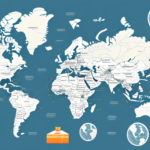International Home Delivery: A Comprehensive Guide to Shipping Abroad
If you are selling products online or considering expanding your business to reach a global audience, international home delivery is crucial to your success. In this comprehensive guide, we will cover everything you need to know about shipping abroad—from understanding the logistics of international shipping to overcoming common challenges, tracking your shipment, and more.
Why International Home Delivery is Becoming More Popular
With the rise of e-commerce and the increasing number of online shoppers, the demand for international home delivery has been on the rise. According to Statista, global e-commerce sales reached over $5 trillion in 2021 and are projected to continue growing. More consumers are seeking products from other countries that are not available in their local stores. Businesses recognize the vast opportunities of expanding their markets globally to increase sales and revenue. Providing convenient and reliable shipping options through international home delivery is key to tapping into these opportunities.
Advancements in technology have significantly contributed to the popularity of international home delivery. With sophisticated logistics software, shipping companies can now offer faster and more efficient delivery services, reducing delivery times by up to 30%. This efficiency is a significant factor in customer decision-making processes.
Additionally, the increasing number of expats and international students has fueled the demand for international home delivery. These individuals often struggle to find products from their home countries in their new locations. International home delivery provides them with a convenient way to access the products they miss and love, no matter where they are in the world.
Understanding the Logistics of International Shipping
International shipping can be complex and challenging due to various factors such as customs regulations, parcel weight and dimensions, packaging restrictions, and documentation requirements. To overcome these obstacles, it's best to work with an experienced shipping provider that can handle all the logistics for you. This includes providing accurate shipping quotes, managing paperwork, and navigating customs clearance processes.
One of the biggest challenges of international shipping is dealing with different time zones and language barriers. This can make communication with overseas suppliers, customers, and shipping companies difficult. It's important to have a shipping provider that can effectively communicate with all parties involved and provide updates on the status of your shipment.
Another important factor to consider when shipping internationally is the potential for unexpected delays or issues. This can include weather-related delays, customs inspections, or transportation disruptions. Having a shipping provider that can quickly address any issues that arise and provide alternative solutions ensures your shipment arrives on time and in good condition.
Factors to Consider When Choosing an International Shipping Provider
When selecting an international shipping provider, several factors should be considered:
- Pricing: Compare shipping rates to find the most cost-effective option.
- Delivery Time: Ensure the provider can meet your delivery timelines.
- Package Tracking: Choose a provider that offers real-time tracking for transparency.
- Customer Service: Reliable support is essential for resolving any issues that may arise.
Ensure the provider has extensive network coverage, including the countries you plan to ship to. This guarantees timely and hassle-free deliveries.
Experience and expertise in handling international shipments are crucial. Providers well-versed in customs regulations, documentation requirements, and other factors can ensure smooth deliveries without delays or issues.
Tips for Packing and Preparing Items for International Shipping
Packaging your products carefully and correctly is vital to ensure they arrive safely and securely at their destination. Consider the following when shipping abroad:
- Materials: Use durable packaging materials to protect your products during transit.
- Size and Shape: Optimize package size and shape to minimize shipping costs and prevent damage.
- Labeling and Documentation: Clearly label packages and include all necessary documentation to comply with international shipping regulations.
Research the destination country's customs regulations to avoid delays or confiscation. Working with a customs broker or freight forwarder can help navigate complex customs processes and ensure compliance with all regulations.
Understanding Customs and Import Regulations
Each country has its own set of import regulations and requirements for shipping products across borders. These regulations may include:
- Product Restrictions: Certain items may be prohibited or require special permits.
- Import Taxes and Fees: Duties and taxes can impact the overall cost of shipping.
- Documentation Requirements: Accurate paperwork is essential for smooth customs clearance.
Stay informed about changes to import regulations by consulting with local import authorities or your shipping provider. Some countries may require specific certifications or labeling for certain products, so thorough research is necessary to ensure compliance and avoid shipment delays.
How to Track Your International Shipment
Tracking your shipment is essential for monitoring the status of your packages and providing customers with accurate delivery information. Most shipping providers offer tracking services that allow you to monitor your shipment's progress from start to finish. Utilizing these tracking tools helps quickly address any issues that may arise and ensures timely delivery.
Common Challenges with International Shipping and How to Overcome Them
International shipping presents several challenges, including:
- Delivery Delays: Can be caused by customs inspections, weather conditions, or transportation issues.
- Lost Packages: Proper labeling and using reliable shipping providers can mitigate this risk.
- Customs Clearance Problems: Ensuring accurate documentation and understanding regulations helps prevent delays.
To address these challenges, work with a reputable shipping provider experienced in international shipping. Additionally, consider purchasing shipping insurance and selecting secure delivery options to protect your shipments.
Comparing the Costs of Different International Shipping Options
The cost of international shipping varies based on factors such as package weight and size, destination, and shipping speed. When selecting a shipping provider, compare the following to ensure you get the best value:
- Shipping Rates: Analyze different pricing models to find the most cost-effective option.
- Delivery Services: Consider the range of services offered, including express and economy options.
- Additional Fees: Be aware of customs duties, taxes, and fuel surcharges that may apply.
Use online comparison tools and consult with shipping providers to evaluate costs and services comprehensively.
How to Ensure Safe Delivery of Your Package Abroad
Ensuring the safe and secure delivery of your packages abroad is critical for your business's reputation. Implement the following measures:
- Sturdy Packaging: Use high-quality materials to protect products during transit.
- Accurate Labeling: Clearly label packages with the correct address and contact information.
- Reliable Shipping Provider: Choose a provider with a strong track record for secure deliveries.
- Tracking: Monitor shipments to address any issues promptly.
Adhering to all customs regulations and working with your shipping provider ensures your packages arrive safely and without delays.
Benefits and Drawbacks of Using a Third-Party Shipping Service
Using a third-party shipping service offers several benefits and drawbacks:
Benefits
- Lower shipping rates through bulk pricing.
- Faster delivery times with established logistics networks.
- Extensive tracking and customer service options.
Drawbacks
- Limited package size and weight restrictions.
- Loss of control over the shipping process.
- Potential delays or delivery problems beyond your control.
Carefully weigh the pros and cons of using a third-party provider to determine if it aligns with your business needs.
Top Countries for International Home Delivery and Their Requirements
When shipping internationally, it's essential to be familiar with the destination country's import requirements and regulations. Some of the top countries for international home delivery include:
- United States: Requires detailed documentation and adherence to specific import regulations.
- United Kingdom: Post-Brexit regulations necessitate a thorough understanding of customs requirements.
- Canada: Import duties and taxes must be calculated accurately.
- Australia: Strict biosecurity laws require careful preparation of shipments.
- Germany: As a major EU hub, compliance with EU regulations is crucial.
Your shipping provider should be able to advise you on the specific requirements for each destination country to ensure smooth deliveries.
The Future of International Home Delivery: Trends and Predictions
The future of international home delivery is promising, driven by technology and innovation. Key trends include:
- Faster Shipping Times: Advancements in logistics will continue to reduce delivery times.
- Automation and Robotics: Increased use of automated systems in warehouses and sorting facilities.
- Sustainability Initiatives: Eco-friendly packaging and greener transportation methods are gaining importance.
- Blockchain Technology: Enhancing transparency and security in the shipping process.
These trends will enable businesses to expand their global reach and provide customers with more convenient and reliable shipping options.
Best Practices for Communicating with Your Customers During the Shipping Process
Clear communication is essential for providing a positive and seamless shipping experience for your customers. Implement the following best practices:
- Automated Messaging: Use automated emails or SMS updates to keep customers informed about their shipment status.
- Accurate Delivery Estimates: Provide realistic delivery timelines to manage customer expectations.
- Responsive Support: Address customer inquiries and issues promptly to maintain trust and satisfaction.
Effective communication helps build customer loyalty and enhances the overall shopping experience.
How to Handle Returns and Refunds for International Orders
Handling returns and refunds for international orders can be challenging, but the following strategies can streamline the process:
- Return Services: Partner with a shipping provider that offers return services to simplify the process for customers.
- Clear Policies: Establish and communicate clear return and refund policies to avoid misunderstandings.
- Efficient Customer Service: Provide responsive support to address any issues related to returns or refunds.
Implementing these practices ensures a smooth returns process, enhancing customer satisfaction and trust.
The Role of Technology in Streamlining the International Shipping Process
Technology has significantly streamlined the international shipping process, making it faster, more efficient, and cost-effective. Key technologies include:
- Cloud-Based shipping software: Facilitates order management, tracking, and automation.
- Automated Packaging Systems: Enhance packing efficiency and reduce errors.
- Real-Time Parcel Tracking and Analytics: Provide visibility into shipment status and performance metrics.
Implementing these technologies allows businesses to optimize their shipping operations, reduce costs, and deliver superior customer service.
Case Studies: Success Stories in International Home Delivery
Several companies have achieved remarkable success in international home delivery by leveraging effective shipping strategies:
- Amazon: Uses advanced logistics and extensive fulfillment networks to offer fast and reliable international shipping.
- Alibaba: Implements comprehensive supply chain management and utilizes global partners to facilitate international deliveries.
- Zara: Employs efficient inventory management and quick turnaround times to meet global customer demands.
Studying these success stories provides valuable insights into strategies that drive excellence in international shipping.
Conclusion: Making the Most Out of Your International Home Delivery Experience
International home delivery presents numerous opportunities for businesses and consumers alike, but it also comes with unique challenges. By partnering with a reliable and experienced shipping provider, understanding customs regulations, properly packaging and preparing your items, and leveraging technology and innovative solutions, you can maximize your international home delivery experience. This approach will help you grow your business and reach customers worldwide, ensuring long-term success in the global marketplace.






















